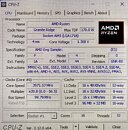- Joined
- Aug 19, 2017
- Messages
- 2,999 (1.07/day)
Recent engineering samples of AMD's upcoming Ryzen 9 9950X3D reveal what appear to be the finalized specifications of the top-tier AM5 chip. The 16-core, 32-thread processor builds upon the gaming success of the Ryzen 7 9800X3D while addressing its core count limitations. The flagship processor features AMD's refined cache design, combining 96 MB of 3D V-Cache with 32 MB of standard L3 cache. Unlike its predecessor, the 7950X3D, the new Zen 5 architecture incorporates a redesigned CCD stacking method. The CCD now sits above the cache, directly interfacing with the STIM and IHS, eliminating thermal constraints that previously required frequency limitations. The processor features asymmetric cache distribution across its dual CCDs—one die combines 32 MB of base L3 cache with a 64 MB stacked V-Cache layer, while its companion die utilizes a standard 32 MB L3 cache configuration. In total, there is a 128 MB of L3 cache, with 16 MB of L2.
This architectural advancement enables the 9950X3D to achieve a 5.65 GHz boost clock across both CCDs, matching non-X3D variants. The processor maintains a 170 W TDP, suggesting improved thermal efficiency despite the additional cache. AMD's software-based OS scheduler will continue to optimize gaming workloads by directing them to the CCD with 3D V-Cache. Early leaks indicate the 9950X3D matches the base 9950X in Cinebench R23 scores, both in single and multi-threaded tests—a significant improvement over the 7950X3D, which lagged behind its non-X3D counterpart due to frequency limitations. AMD plans to expand the Zen 5 X3D lineup in Q1-2025 with both the 9950X3D and 9900X3D models. Full performance benchmarks and pricing details are expected at CES 2025, where AMD will officially unveil these processors alongside their RDNA 4 GPUs.

View at TechPowerUp Main Site | Source
This architectural advancement enables the 9950X3D to achieve a 5.65 GHz boost clock across both CCDs, matching non-X3D variants. The processor maintains a 170 W TDP, suggesting improved thermal efficiency despite the additional cache. AMD's software-based OS scheduler will continue to optimize gaming workloads by directing them to the CCD with 3D V-Cache. Early leaks indicate the 9950X3D matches the base 9950X in Cinebench R23 scores, both in single and multi-threaded tests—a significant improvement over the 7950X3D, which lagged behind its non-X3D counterpart due to frequency limitations. AMD plans to expand the Zen 5 X3D lineup in Q1-2025 with both the 9950X3D and 9900X3D models. Full performance benchmarks and pricing details are expected at CES 2025, where AMD will officially unveil these processors alongside their RDNA 4 GPUs.

View at TechPowerUp Main Site | Source








 .
.
